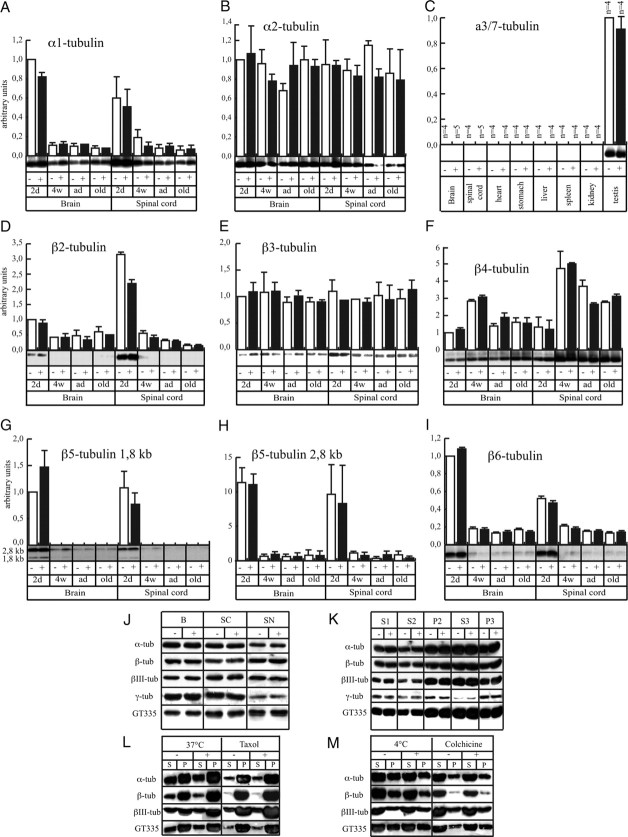Figure 7.
The amount of α- and β-tubulin mRNA and protein is similar between transgenic (+) and control (−) samples. A, During aging, a similar 10-fold decrease of mouse α-tubulin isoform 1 (Mα1) tubulin mRNA occurred both in brain and spinal cord of control and transgenic mice (2d, 2 d; 4w, 4 weeks; ad, adult; old, >24-month-old animals). Mean ± SE is shown. B, Mα2 mRNA remained constant during postnatal development of NFHLacZ mice. C, Mα3/7 tubulin mRNA was detected only in testis. D, Mouse β-tubulin isoform 2 (Mβ2) tubulin mRNA decreased 3-fold in brain and 10-fold in spinal cord in both control and transgenic samples. E, Mβ3 tubulin accumulated to similar levels in both normal and transgenic mice. F, Mβ4 tubulin mRNA showed a two-phase profile in developing brain and spinal cord samples. First, Mβ4 mRNA levels increased in brain threefold between 2 d and 4 weeks, and fivefold in spinal cord. Thereafter, Mβ4 tubulin mRNA decreased by a factor of 2 both in brain and spinal cord. G, H, Two Mβ5 transcripts exhibited a similar pattern of expression in control and transgenic spinal cords. The 2.8 kb transcript was expressed 10-fold higher than the 1.8 kb transcript, and during aging, both decreased by 10-fold. I, Mβ6 tubulin mRNA decreased by fivefold in brain and threefold in spinal cord in early postnatal development. J, Specific antibodies against different tubulin epitopes revealed no major difference in tubulin quantity present in total homogenates of brain (B), spinal cord (SC), or sciatic nerves (SN) between control and transgenic samples. K, After a classical preparation of MTs from the brains of normal and transgenic mice, each fraction was analyzed for tubulin content. No obvious difference was observed between the two genotypes. L, M, The first supernatants (S1) from brain of control and transgenic mice were exposed 1 h at 37°C with 1 mm GTP alone (37°C), or with Taxol to induce MT polymerization. Alternatively, the same S1 fraction was incubated at 4°C to block polymerization, or with colchicine. These mixtures were centrifuged at 100,000 × g for 30 min in the same incubation conditions, and supernatants and pellets were analyzed for tubulin epitopes by Western blotting. Control and transgenic samples yielded similar results.

